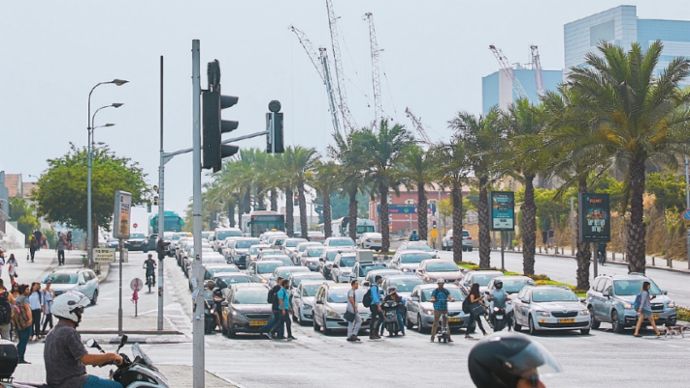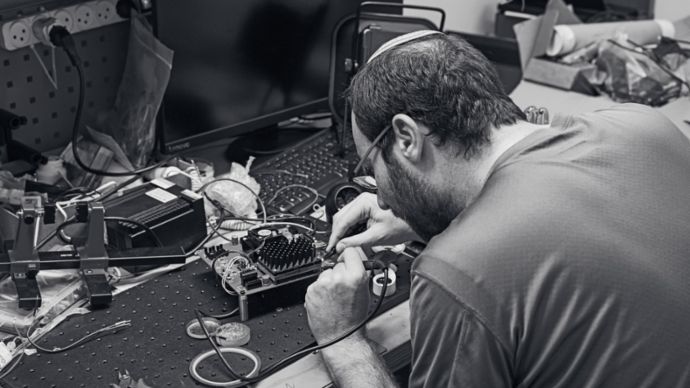On the Trail of Start-Ups in Tel Aviv
No other city in the world has a higher density of start-ups than Tel Aviv. We joined tech scout Sigalit Klimovsky on her search for talent and ideas for the future of mobility.
The view from the thirty-fourth floor extends beyond the office towers and flat Bauhaus roofs, past small houses from the city’s early days, and out to the Mediterranean. The mirrored twin towers behind the highway in Tel Aviv are like an aerie for autonomous driving innovations. A team from the start-up TriEye is here working on a camera that promises to peer beyond what humans can see—and thereby solve one of mobility’s greatest challenges. TriEye was founded at the Hebrew University, whose nanophotonics department is considered one of the world’s best.

The first encounter with the Porsche Taycan:
Sigalit Klimovsky holds the 1:10 scale model in her hands.Back to the thirty-fourth floor. Wearing jeans and a casual blouse, Sigalit Klimovsky, forty-seven, stands in front of a demonstration model. Together with her business partner Dov Moran, inventor of the USB stick, she began specializing in investments in the deep-tech sector four years ago. That is, in companies that pursue technological as opposed to purely economic disruption. Klimovsky accompanies founders right from the start for the risk capital fund Grove Ventures.
Right now she’s holding a piece of milky glass in front of a toy car. The idea is to simulate heavy fog. In situations like this, the human eye is helpless. But the shortwave infrared sensor of the tiny camera installed in the car transmits a clear image. Despite low visibility conditions, the system manages to see. Sensors of this type are so expensive that they’re only used for military, aerospace, and medical purposes. TriEye now produces them for a fraction of the cost.
“Grove took a huge risk by investing in TriEye,” says the young man next to Klimovsky. “But we proved that our technology works.” Ziv Livne is responsible for business development at the start-up, and he used to be a member of the team at Grove Ventures. “It’s a good example of how interrelated the community is here in Tel Aviv,” explains Klimovsky. A lot happens with the help of personal recommendations.
“Israel is an incredibly exciting ecosystem,” she stresses. It has plenty of talent, accelerators, and incubators, as well as a government that’s willing to invest in research. It also has success stories that inspire emulation, like the Jerusalem-based start-up Mobileye that Intel acquired for US$15.3 billion in 2017. In the first half of 2019 alone, sixty-six companies in Israel were sold for the record sum of US$14.84 billion.
6,500
high-tech companies are based in Israel.
Another 1,200 to 1,500 new start-ups appear every year.
The country has around 6,500 high-tech companies, with another 1,200 to 1,500 new start-ups appearing every year. A total of 530 multinational corporations have a presence, including Facebook, Apple, Google, and Amazon. Tel Aviv plays a key role. There’s nowhere else in the world where so many start-ups are concentrated in such a small area. It has more than four thousand recently founded companies for a population of barely half a million. The city is extreme—extremely energetic and extremely young. People live every minute of their lives intensely here. This mentality, of course, also stimulates the start-up scene. A hunger to experience life goes hand in hand with a drive to achieve great things quickly.
Porsche opened a digital lab in Tel Aviv in 2017 with the aim of scouting for talented people and future-oriented technologies. “Porsche Digital is an investor in the Grove fund and a strategic partner. Together, we’re on the lookout for innovations and share our insights about the ecosystem and the needs of the industry,” says Klimovsky. The fact that collaboration brings together more than two cultures—a fast-moving, agile start-up scene and an established multinational sports-car manufacturer—is sometimes a challenge but largely an advantage, she adds. “The point is to find the right rhythm that fits both.”


The TriEye camera’s image sensor:
This chip gives the start-up its competitive edge.Sigalit Klimovsky herself has experienced a wide range of corporate cultures over the course of her career. She worked in Australia for five years. With her soft spot for technology and physics and her worldwide experience, she feels just as at home among technology start-ups as she does among company managers. She likes to meet her colleagues from Porsche Digital as well as promising founders at the Grove Ventures headquarters in the north of Tel Aviv or in the small city office not far from the tower where TriEye is based. LABS TLV is the name of the luxurious co-working space. When the elevator makes its rapid descent, an animated toucan swoops down on an enormous screen along with it.
Yet the surroundings outside the door are on the modest side, at least at first glance. Restored gabled houses stand out among flat roofs. In the background, the antenna-bedecked tower next to the helicopter landing pad on the roof of the defense ministry reinforces the realization that expertise and an entrepreneurial spirit here are not due solely to the presence of excellent universities. In hardly any other country on earth do the military, industry, and research sectors exchange talented individuals and new technologies as fruitfully as in Israel. Yet it would be wrong to assume the country’s start-up scene works to support the interests of the state. “We have little respect for hierarchies or authority,” remarks Klimovsky. “If you ask a question here, you’ll get another question in response. Some would call that chutzpah, the Jewish art of cheek. Others would say we like to challenge each other.”


The flat hierarchies might derive from the country’s early years, when its pioneers were not yet developing semiconductors but turning swamps into arable land and sharing all their worldly goods on kibbutzim—not to mention eating meals together in the latter’s communal dining halls.
Most of the collective settlements have long been privatized, but nostalgia shines through when Klimovsky decides to have lunch at Chadar Ha’Ochel. This restaurant evokes memories of spartan kibbutz dining halls—even when a waiter appears at the table with fish kebabs and fancy salads. Chadar Ha’Ochel is located next to the art museum, whose modern architecture features geometric folds akin to a piece of origami. A fine place to look into the future.


Mobile, dynamic, vibrant:
Young people live every minute of their lives intensively in Tel Aviv.Tel Aviv has chutzpah
Klimovsky believes that digital services and personalization will point the way to a new transformation as soon as the promise of electric and self-driving vehicles has been fulfilled. “I expect the current trend of using artificial intelligence in the automotive industry to expand even faster than it is today.” Knowing the needs and habits of vehicle occupants “will help develop new services tailored to specific customer segments,” Klimovsky predicts. “Many things are conceivable—new business models could be based on shopping, entertainment, work, health, and much more.”
But now Klimovsky has to pick up her eight-year-old son from school, so she bids farewell and heads toward Rothschild Boulevard. Here on the main street of Tel Aviv, a phenomenon of the sharing economy can be observed. Hipsters and businesspeople zoom past each other under the crowns of the flame trees lining the thoroughfare. Israel may well produce crucial solutions when it comes to digitalizing cars, but a different method of transportation is currently on the rise in the country itself: the handy electric scooter.


TriEye: AI with eagle eyes
Founded in 2017, this start-up is taking on one of the biggest challenges for driver assistance systems and autonomous driving: safety in low visibility. TriEye’s shortwave infrared (SWIR) cameras are not only state-of-the-art systems, but also cost just a fraction of conventional production thanks to semiconductor technology. Whether in fog, rain, snow, or darkness, a coin-sized camera provides the vehicle with high-resolution image data. The sensor responds not only to an object’s colors but also to its material composition, thus recognizing black ice, oil spills, and the dark fur of animals, all of which registers from a distance. Even the windshield doesn’t impair the camera’s efficiency, so no compromises need be made to the visuals when designing car bodies. Porsche has had a stake in TriEye since this summer.
www.trieye.tech
Fleetonomy: speedy revolution
Car service requirements, short-term rentals, and subscription models: this is what mobility could look like in the cities of the future as artificial intelligence is used to control ever more autonomous vehicles and fleets. Founded in 2016, Fleetonomy promises a smooth progression to this autonomous revolution and is already managing and optimizing the fleets of automotive manufacturers, rental car companies, and other operators around the world. Artificial intelligence gathers and analyzes big data to utilize the vehicles as efficiently as possible, precisely calculate demand, and adjust services in real time to customers’ needs. The entire spectrum of mobility services can be simulated early on in planning stages and tailored to individual customer profiles for specific contexts.
www.fleetonomy.io
Anagog: by no means analog
In an age of data, people carry smartphones and tablets and wear digital watches that accumulate information all the time. This is often a cause for concern. Who should benefit from all this information? According to the people at Anagog, a start-up founded in 2010, only the users themselves should. Although the idea of artificial intelligence is usually associated with enormous computers, Anagog’s software plays out on our smartphones. Their sensors generate data on location, elevation, and speed—or with patterns like the vibrations generated by a car in motion. The new Edge-AI technology not only predicts when we’ll head back to our car from an appointment and adjusts the car’s temperature in advance, but also foretells where a parking space will open up in the next few minutes. The great thing about it: unlike with all previous solutions, all data always remain on the user’s phone, marking a new departure in data protection.
www.anagog.com

